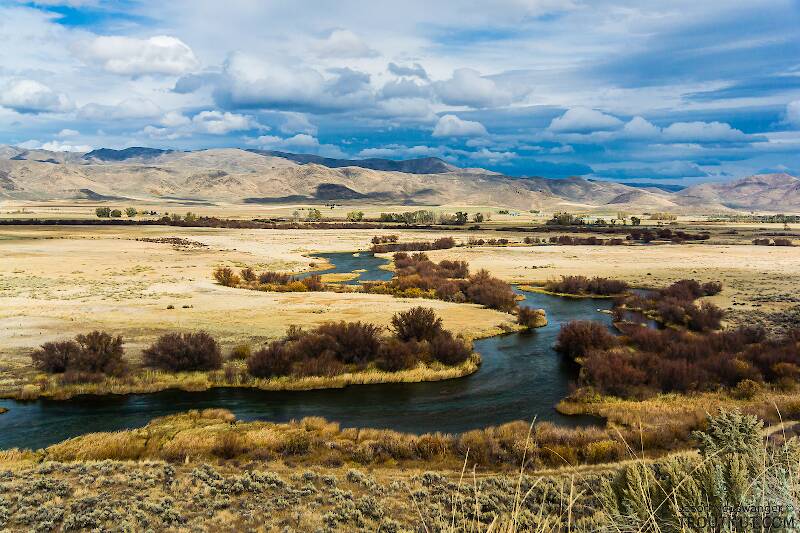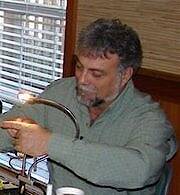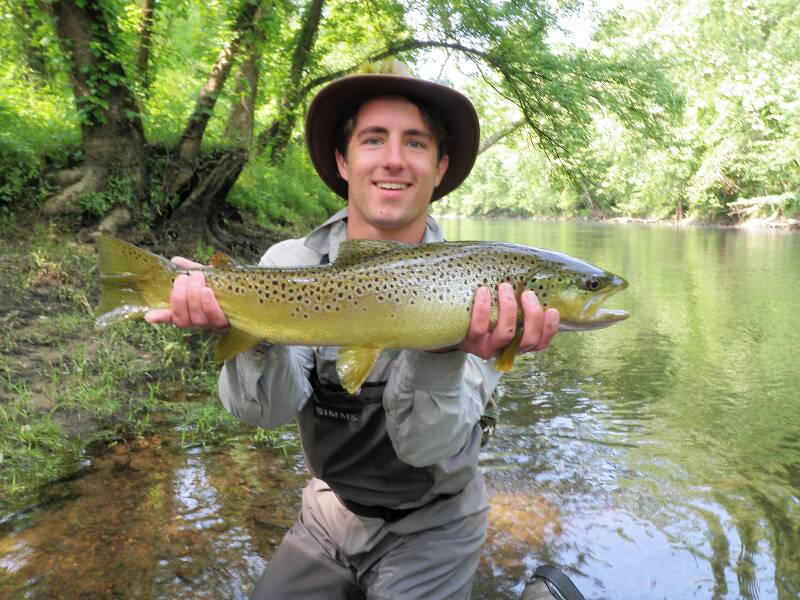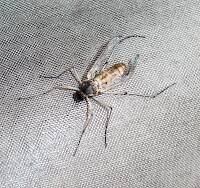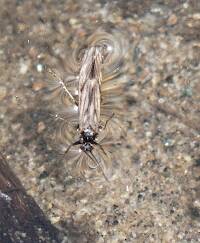
Blue-winged Olives
Baetis
Tiny Baetis mayflies are perhaps the most commonly encountered and imitated by anglers on all American trout streams due to their great abundance, widespread distribution, and trout-friendly emergence habits.
Featured on the forum

This species was fairly abundant in a February sample of the upper Yakima.

Troutnut is a project started in 2003 by salmonid ecologist Jason "Troutnut" Neuswanger to help anglers and
fly tyers unabashedly embrace the entomological side of the sport. Learn more about Troutnut or
support the project for an enhanced experience here.
Taxon on Nov 27, 2010November 27th, 2010, 1:34 pm EST
My goodness, Fred, even halteres. Who would'da thunk?
Jesse on Nov 27, 2010November 27th, 2010, 5:45 pm EST
id almost be scared to cast it and risk loosing it its so beautiful ha!
Most of us fish our whole lives..not knowing its not the fish that we are after.
http://www.filingoflyfishing.com
http://www.filingoflyfishing.com
FredH on Nov 28, 2010November 28th, 2010, 1:39 am EST
Thanks Roger and Jesse . The abdomen and thorax are deerhair wrapped in thread covered with Flexament .The legs are paintbrush bristles and the eyes and hateres are mono. The wings are the only part that took some time to put together ,but with it's simple durable components it's worth casting at fish. Not sure how it will land with the wings out as they are , I might have to add a parachute to ensure it lands correctly on the water.
Fred
Fred
PaulRoberts on Nov 29, 2010November 29th, 2010, 3:44 am EST
Very cool, Fred!
FredH on Nov 29, 2010November 29th, 2010, 5:58 am EST
Thanks Paul , I appreciate you taking the time to comment.
Fred
Fred
Gutcutter on Nov 29, 2010November 29th, 2010, 8:26 am EST
fred - that looks very real. nicely done.
do you have any patterns that don't require a "parachute" to imitate adult crane flies. and, while we are at it, do you (or anybody else) have something a little more realistic than a "walt's worm" for the crane fly larvae?
now, i've caught my share on a walt's worm (and honey bugs, green weenies etc.) but i would feel better about myself drifting something more realistic, but not too realistic if you know what i mean.
i think that crane flies are very under appreciated as trout food.
do you have any patterns that don't require a "parachute" to imitate adult crane flies. and, while we are at it, do you (or anybody else) have something a little more realistic than a "walt's worm" for the crane fly larvae?
now, i've caught my share on a walt's worm (and honey bugs, green weenies etc.) but i would feel better about myself drifting something more realistic, but not too realistic if you know what i mean.
i think that crane flies are very under appreciated as trout food.
All men who fish may in turn be divided into two parts: those who fish for trout and those who don't. Trout fishermen are a race apart: they are a dedicated crew- indolent, improvident, and quietly mad.
-Robert Traver, Trout Madness
-Robert Traver, Trout Madness
PaulRoberts on Nov 29, 2010November 29th, 2010, 8:56 am EST
I have one. Will photo and share soon.
RleeP on Nov 29, 2010November 29th, 2010, 9:09 am EST
Tony: No photos, sorry. Good pattern though.
Here's one that I've had success with not only in PA, but also on the spring creeks of WI and Iowa. It's pretty simple and comes from Ross Mueller, who has written a couple of books on fishing the Midwestern Spring Creeks.
Hook: #18 dry fly hook, your choice. I like the Cabela's Model 4 straight eye hooks.
Body/Abdomen: cream/yellow fur or synthetic dubbing, fine and thin. Start the body well down into the hook bend.
Thorax: a little sulfur orange dubbing. The thorax should take up no more than about 1/6th of the overall length of the body. Pretty short.
Wings: a pair of white/cream hackle tips tied delta-style. Wings should extend about 1/3 of the shank length beyond the bend
Hackle: Cream, way oversize. Wrap over front portion of the orange thorax figure-8 around the wings. Use a hackle you might use on a size #6 fly. Then clip the bottom flush to the hook.
This is a pretty effective fly. but in my experience, trout focus on craneflies pretty sporadically and there will be lots of times when it isn't worth a hoot. But when they are on them, it's a good fly.
Here's one that I've had success with not only in PA, but also on the spring creeks of WI and Iowa. It's pretty simple and comes from Ross Mueller, who has written a couple of books on fishing the Midwestern Spring Creeks.
Hook: #18 dry fly hook, your choice. I like the Cabela's Model 4 straight eye hooks.
Body/Abdomen: cream/yellow fur or synthetic dubbing, fine and thin. Start the body well down into the hook bend.
Thorax: a little sulfur orange dubbing. The thorax should take up no more than about 1/6th of the overall length of the body. Pretty short.
Wings: a pair of white/cream hackle tips tied delta-style. Wings should extend about 1/3 of the shank length beyond the bend
Hackle: Cream, way oversize. Wrap over front portion of the orange thorax figure-8 around the wings. Use a hackle you might use on a size #6 fly. Then clip the bottom flush to the hook.
This is a pretty effective fly. but in my experience, trout focus on craneflies pretty sporadically and there will be lots of times when it isn't worth a hoot. But when they are on them, it's a good fly.
FredH on Dec 1, 2010December 1st, 2010, 1:46 am EST
Oldredbarn on Dec 1, 2010December 1st, 2010, 3:55 am EST
Paul & Fred,
My only concern is hooking ability...When I use to toss marabou streamers I had issues with "short-strikes"...I actually rolled some very nice trout only to find out they had chomped down on the fly's tail...I would get one heart pounding roll and away they would go...
With the realistic crane fly there I'm not sure that the trout might not push the fly away from itself when it rose to it...There seems to always be some issues between realism and function. Some materials look great at the bench but on the stream don't always work so well.
Just my eleven-and-a-half cents worth.
Spence
Nice journal there Paul. Fred that fly does look like it could fly away!
My only concern is hooking ability...When I use to toss marabou streamers I had issues with "short-strikes"...I actually rolled some very nice trout only to find out they had chomped down on the fly's tail...I would get one heart pounding roll and away they would go...
With the realistic crane fly there I'm not sure that the trout might not push the fly away from itself when it rose to it...There seems to always be some issues between realism and function. Some materials look great at the bench but on the stream don't always work so well.
Just my eleven-and-a-half cents worth.
Spence
Nice journal there Paul. Fred that fly does look like it could fly away!
"Even when my best efforts fail it's a satisfying challenge, and that, after all, is the essence of fly fishing." -Chauncy Lively
"Envy not the man who lives beside the river, but the man the river flows through." Joseph T Heywood
"Envy not the man who lives beside the river, but the man the river flows through." Joseph T Heywood
PaulRoberts on Dec 1, 2010December 1st, 2010, 4:22 am EST
Fred, I think my post, in response to Tony, might have been invading your thread some, so I moved it into it's own thread.
Since your adult crane will be fished dead drift, it isn't as likely to be "short struck" as a larger active fly would. The gap does look small though. Hope you don't mind the critiques, as well as the accolades; Good flies are worth considering from all aspects.
If you have trouble getting it to land upright, you might try bending the leg joints upwards. I know this isn't anatomically correct, but putting the legs at a dihedral position will allow the body weight to act as a keel. It should land upright that way. Also, notice in the photo of the real insect how the distal leg joint bends upwards so the tarsus lays flat on a surface. You might be able to bend the femur up above the body plane, then bend the tibia down so it's flat (and above body plane) and then bend the tarsus up. Might look good and land correctly. Just some thoughts.
LOVE what you're doing.
Since your adult crane will be fished dead drift, it isn't as likely to be "short struck" as a larger active fly would. The gap does look small though. Hope you don't mind the critiques, as well as the accolades; Good flies are worth considering from all aspects.
If you have trouble getting it to land upright, you might try bending the leg joints upwards. I know this isn't anatomically correct, but putting the legs at a dihedral position will allow the body weight to act as a keel. It should land upright that way. Also, notice in the photo of the real insect how the distal leg joint bends upwards so the tarsus lays flat on a surface. You might be able to bend the femur up above the body plane, then bend the tibia down so it's flat (and above body plane) and then bend the tarsus up. Might look good and land correctly. Just some thoughts.
LOVE what you're doing.
FredH on Dec 1, 2010December 1st, 2010, 4:34 am EST
Thanks Spence and Paul for the advice and critiques . Your insights will be added to the designs of my next attempt.
Fred
Fred
Quick Reply
Related Discussions
Topic
Replies
Last Reply
0
Dec 7, 2006
by Troutnut
by Troutnut

